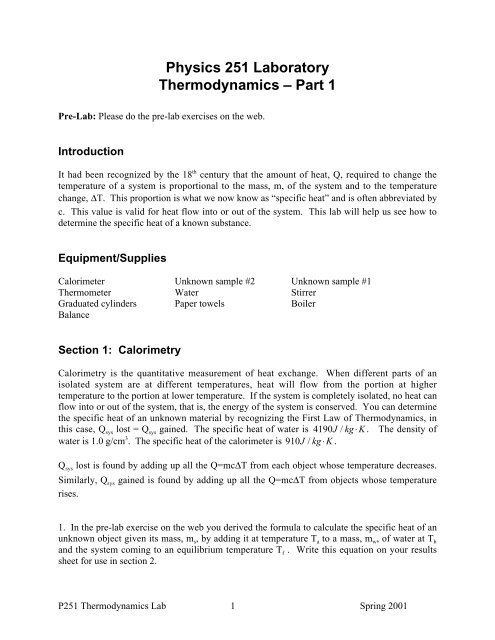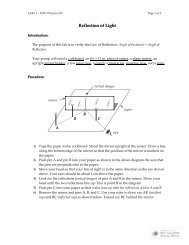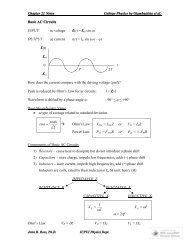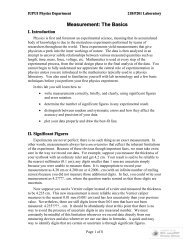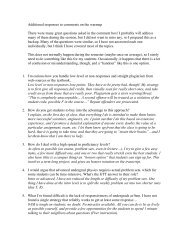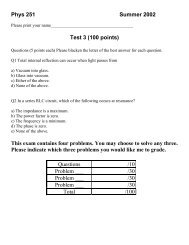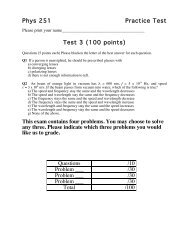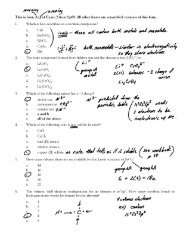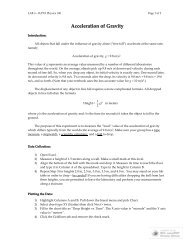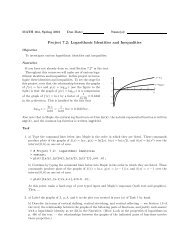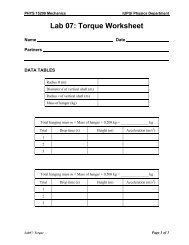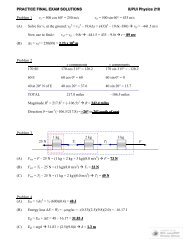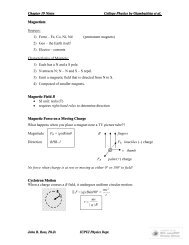Physics 251 Laboratory Thermodynamics â Part 1 - Web Physics
Physics 251 Laboratory Thermodynamics â Part 1 - Web Physics
Physics 251 Laboratory Thermodynamics â Part 1 - Web Physics
Create successful ePaper yourself
Turn your PDF publications into a flip-book with our unique Google optimized e-Paper software.
<strong>Physics</strong> <strong>251</strong> <strong>Laboratory</strong><strong>Thermodynamics</strong> – <strong>Part</strong> 1Pre-Lab: Please do the pre-lab exercises on the web.IntroductionIt had been recognized by the 18 th century that the amount of heat, Q, required to change thetemperature of a system is proportional to the mass, m, of the system and to the temperaturechange, ∆T. This proportion is what we now know as “specific heat” and is often abbreviated byc. This value is valid for heat flow into or out of the system. This lab will help us see how todetermine the specific heat of a known substance.Equipment/SuppliesCalorimeter Unknown sample #2 Unknown sample #1Thermometer Water StirrerGraduated cylinders Paper towels BoilerBalanceSection 1: CalorimetryCalorimetry is the quantitative measurement of heat exchange. When different parts of anisolated system are at different temperatures, heat will flow from the portion at highertemperature to the portion at lower temperature. If the system is completely isolated, no heat canflow into or out of the system, that is, the energy of the system is conserved. You can determinethe specific heat of an unknown material by recognizing the First Law of <strong>Thermodynamics</strong>, inthis case, Q sys lost = Q sys gained. The specific heat of water is 4190J / kg⋅ K. The density ofwater is 1.0 g/cm 3 . The specific heat of the calorimeter is 910J / kg⋅ K.Q sys lost is found by adding up all the Q=mc∆T from each object whose temperature decreases.Similarly, Q sys gained is found by adding up all the Q=mc∆T from objects whose temperaturerises.1. In the pre-lab exercise on the web you derived the formula to calculate the specific heat of anunknown object given its mass, m s , by adding it at temperature T a to a mass, m w , of water at T band the system coming to an equilibrium temperature T f . Write this equation on your resultssheet for use in section 2.P<strong>251</strong> <strong>Thermodynamics</strong> Lab 1 Spring 2001
2. Develop an experiment to determine the specific heat of an unknown sample using theformula you derived for number 1 and using the materials listed above. Use a large amount ofmetal (on the order of 300g) when you design your experiment.Section 21. Using the procedure you have developed in Section 1, experimentally determine the specificheat of unknown sample #1.What value did you obtain for the specific heat? Using the table in your book, identify thesubstance.2. Using the same procedure, experimentally determine the specific heat of unknown sample #2.What value did you obtain for the specific heat? Using the table in your book, identify thesubstance.DATAUnknown Sample # 1Mass of sampleMass of waterInitial temperature of waterInitial temperature of sampleFinal temperature of systemkgkgο Cο Cο CUnknown Sample #2Mass of sampleMass of waterInitial temperature of waterInitial temperature of sampleFinal temperature of systemkgkgο Cο Cο CP<strong>251</strong> <strong>Thermodynamics</strong> Lab 2 Spring 2001
IceInitial mass of iceMass of waterInitial temperature of waterFinal temperature of systemkgkgο CοCSteamInitial mass of waterInitial mass of calorimeter + waterInitial temperature of waterFinal temperature of waterFinal mass of water + calorimeterAmount of steam condensedkgοCο CkgkgP<strong>251</strong> <strong>Thermodynamics</strong> Lab 4 Spring 2001
NAME__________________________________________DATE___________________<strong>Thermodynamics</strong> <strong>Part</strong> 2ResultsPlease use the back of this page or attach another sheet if you need more room for yourcalculations.Section 1 - ICE1. Derived formula for heat of fusion for water? ________________________________________________________________________________________________________2. Describe how you would go about your experiment____________________________________________________________________________________________________________________________________________________________________________________________________________________________________________________3. Heat of fusion ____________________ Percent Error _________________________Section 2 - STEAM1. Derived formula for heat of vaporization for water?____________________________________________________________________________________________________2. Heat of vaporization ______________________Percent Error ___________________OverallWhat was good about this lab? _______________________________________________________________________________________________________________________________________________________________________________________________What would you do to improve it?_____________________________________________________________________________________________________________________________________________________________________________________________________________________________________________________________________P<strong>251</strong> <strong>Thermodynamics</strong> Lab 6 Spring 2001


